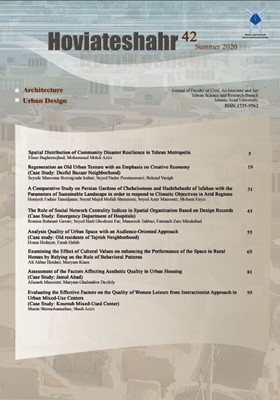Regeneration an old urban texture with an emphasis on creative economy (Case Study: Dezful Bazaar Neighborhood
Subject Areas : urban designSeyede masoome Bozorgzade kuluri 1 , Seyed nader Poormoosavi 2 , Behzad Vasiq 3
1 - M.A. in Urban Design,Jondi Shapur University of Technology, Dezful,Iran
2 - Assistant Professor, Urban Design Department, Jondi Shapur University of Technology, Dezful,Iran.
3 - Assistant Professor, Architecture Department, Jondi Shapur University of Technology, Dezful,Iran.
Keywords: Creative Industries, Dezful-bazaar, Handicrafts, Historical Texture, Creative Economy, Regeneration,
Abstract :
Achieving economic development is one of the most important goals of planners and city managers, which can be achieved through the establishment of urban management system along with access to services and facilities and the utilization of social amenities of residents of the neighborhood. This research focuses on the regeneration of the Dezful bazar neighborhood with an emphasis on creative economics. Strengthening the creative economy or the creative industry is increasingly emphasized by city officials. It is a platform for the development of the economy or even the city as a whole. The creative economy tends to develop in large cities or in centers with historic capital. What is important here is the ability to attract capital and develop natural resources through the attention to local capital and the growth of existing businesses. In this research, the traces of economic regeneration in urban regeneration approaches and theories have been investigated and their role has been clarified and several examples of foreign and domestic urban regeneration projects have been introduced. In this study, firstly, the recognition of the Dezful bazar neighborhood and its historical context as the base studies is examined and then the potential of the creative economy in the neighborhood is discussed. The research methodology is descriptive-analytical based on the subject and objectives. This research is also involved with the case study method, that is, the results of the studies carried out are to provide suggestions for a particular instance (the same neighborhood). Data were collected by a closed questionnaire and a targeted interview. In this study, commercial modeling techniques are used to analyze the information obtained, and the obtained economic indicators are extracted from the results. According to this method, what are the "indicators of creativity that can be effective in regeneration the economist in the Dezful city bazaar neighborhood?" At first, the background of this approach has been studied in the opinions of the thinkers and urban experts and their main ideas have been extracted. Also, by using a questionnaire and interviewing of the bazaar neighborhood, the views of the residents were gathered in relation to the research questions. In the end, proposals will be made regarding bazaar neighborhood regeneration with a creative economics approach, and the practical implications of these proposals will be presented in most executive projects. Data gathered from questionnaires were analyzed using Chi-square, T-test, and Friedman rankings. Finally, with the help of Delphi's comparative test, suitable strategies for a redevelopment of the Dezful city Market neighborhood and the creative economy approach are proposed. At first, the background of this approach has been studied in the opinions of the thinkers and urban experts and their main ideas have been extracted. Also, by using a questionnaire and interviewing of the bazaar neighborhood, the views of the residents were gathered in relation to the research questions. In the end, proposals will be made regarding bazaar neighborhood regeneration with a creative economics approach, and the practical implications of these proposals will be presented in most executive projects.
ایزدی، محمد سعید؛ قلعه نوعی، محمود؛ و خان محمدی، مرجان. (1392). نقش فرهنگ و صنایع خلاق در بازآفرینی شهری. کنفرانس بینالمللی عمران و معماری و توسعه شهرسازی پایدار، دانشگاه آزاد اسلامی، واحد تبریز، آذر 92، 6.
آیینی، محمد. (1392). بررسی جایگاه بازآفرینی اقتصادی در بازآفرینی شهری. اقدامات فرهنگی شرکت عمران شهر جدید اندیشه. بازیابی شده در ۱۳۹۲/۰۹/۲۷، ازhttp://andisheh-ntoir.gov.ir/1504.
حسین زاده، جواد؛ و فرهادی، عزیز اله. (1394). اقتصاد خلاق در ایران. 5-38. تهران: نشر آماره.
رفیعیان، محسن؛ بمانیان، محمدرضا؛ و رفیعیان، مجتبی. (1390). گردشگری شهری به مثابه راهبرد توسعه خلاق در بافتهای فرسوده. منظر. 3(14). 74-79.
عندلیب، علیرضا؛ بیات، اشکان؛ و رسولی، لیلا. (1392). مقایسه و تطبیق بازآفرینی بافتهای فرسودهی شهری بلوک خیام تهران (ایران) و پروژه لیورپول 11 (بریتانیا). فصلنامه آمایش محیط. 1(23)،48.
قلعه نوعی، محمود؛ و خان محمدی، مرجان. (1394). بازآفرینی شهری از طریق تبیین محلههای فرهنگی برای حضور در صنایع خلاق. نشریه شهر پایدار.2(1)،1.
نصیری قرقانی، بابک؛ و امین پیرمحمد زاده. (1395). گردشگری و اقتصاد خلاق. اولین همایش ملی اقتصاد خلاق. تهران. دانشگاه آزاد اسلامی واحد تهران غرب، اسفند،3-4.
Landry, Ch. Greene, L., Matarasso,F., & Bianchini,F. (1996). The Art of Regeneration: Urban Renewal through Cultural Activity, a Comedia Report. London:Comedia.
Likert, R. (1932). A technique for the measurement of attitudes. New York University: Archives of Psychology.
Jones.A,D., & Kimberly, J. (2011). Comparingthe Value Relevance, Predictive Value, andPersistence of other Comprehensive Income and Special Items. The Accounting Review. 86(6), 2047-2073.
Howkins. J. (2001) .The creative economy: how people make money from ideas. Michigan: The University of Michigan. pp.11-12.
Canadian heritage. (2013). The Creative Economy: Key Concepts and Literature Review Highlights. Canada: Edited by the Policy Research Group (PCH).
Smith-Heimer.J,Peninger.P,Fox.N,Harvey.S,Johnson.L,Huntley.W.R,Nottingham.D.A,Padget.R.M, Hill-Christian.S , Linderman.D , Easter.R , (2011). Economic Revitalization Strategy. (Report No. 83-003-XPE). Retrieved from Richmond: Department of Economice Development website http://www.richmondgov.com/EconomicCommunityDevelopment/documents/ShockoeFinalDraftStrategy11_1.pdf


